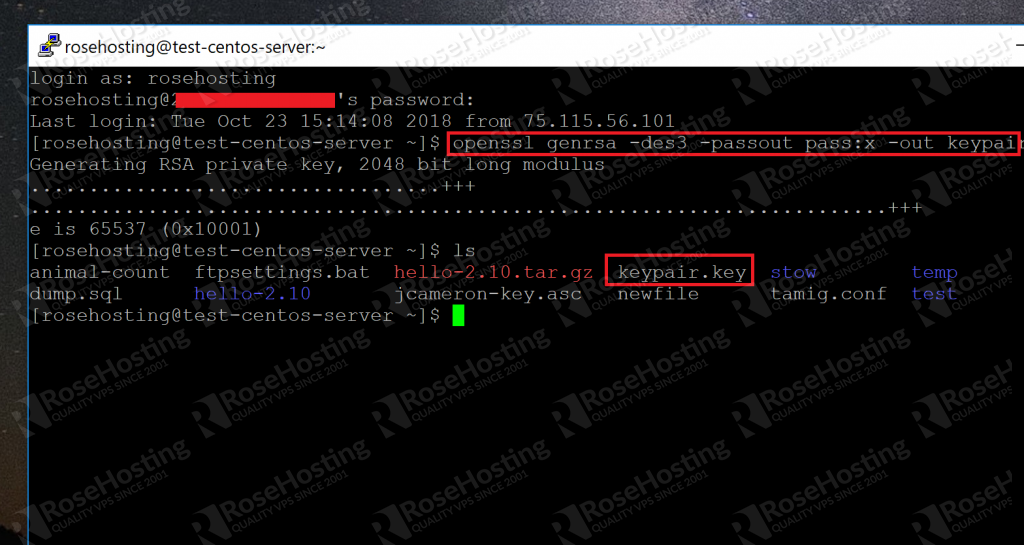Generate Dsa Key Pair Openssl
- Openssl Generate Pem Key
- Generate Dsa Key Pair Openssl Number
- Use Openssl To Generate Key Pair
- Openssl Generate Dsa Key Pair
| *** RSA |
| # Generate self-signed certificate with RSA 4096 key-pair |
| openssl req -x509 -nodes -days 3650 -newkey rsa:4096 -keyout rsakey.pem -out rsacert.pem |
| # print private and public key |
| openssl rsa -in rsakey.pem -text -noout |
| # print certificate |
| openssl x509 -in rsacert.pem -text -noout |
| # generate PKCS#12 container |
| openssl pkcs12 -export -inkey rsakey.pem -in rsacert.pem -out rsacred.p12 |
| *** ECDSA |
| # Generate self-signed certificate with ECDSA using two common curves |
| openssl req -x509 -nodes -days 3650 -newkey ec:<(openssl ecparam -name prime256v1) -keyout ecdsakey.pem -out ecdsacert.pem |
| openssl req -x509 -nodes -days 3650 -newkey ec:<(openssl ecparam -name secp384r1) -keyout ecdsakey.pem -out ecdsacert.pem |
| # print private and public key + curve name |
| openssl ec -in ecdsakey.pem -text -noout |
| # print certificate |
| openssl x509 -in ecdsacert.pem -text -noout |
| # generate container |
| openssl pkcs12 -export -inkey ecdsakey.pem -in ecdsacert.pem -out ecdsacred.p12 |
| Which curve to choose? |
| http://security.stackexchange.com/questions/78621/which-elliptic-curve-should-i-use |
| 'Interoperability' means that you would probably prefer it if SSL clients can actually |
| connect to your server; otherwise, having a SSL server would be rather pointless. |
| This simplifies the question a lot: in practice, average clients only support two curves, |
| the ones which are designated in so-called NSA Suite B: these are NIST curves P-256 and |
| P-384 (in OpenSSL, they are designated as, respectively, 'prime256v1' and 'secp384r1'). |
| If you use any other curve, then some widespread Web browsers (e.g. Internet Explorer, |
| Firefox.) will be unable to talk to your server. |
| *** DSA |
| # generate both key and DSA parameters (both will be stored in dsakey.pem) |
| openssl dsaparam -genkey 1024 -out dsakey.pem |
| openssl req -x509 -new -days 3650 -key dsakey.pem -out dsacert.pem |
| # print private and public key with DSA params |
| openssl dsa -in dsakey.pem -text -noout |
| # print certificate |
| openssl x509 -in dsacert.pem -text -noout |
| # print only DSA params from key file |
| openssl dsaparam -in dsakey.pem -text -noout |
| # generate container |
| openssl pkcs12 -export -inkey dsakey.pem -in dsacert.pem -out dsacred.p12 |
| *** Test TLS connection |
| openssl s_server -accept 1443 -www -key key.pem -cert cert.pem |
| openssl s_client -showcerts -connect localhost:1443 -CAfile cert.pem |
Openssl rsa -in private.pem -outform PEM -pubout -out public.pem. The -pubout flag is really important. Be sure to include it. Next open the public.pem and ensure that it starts with -BEGIN PUBLIC KEY-. This is how you know that this file is the public key of the pair and not a private key. Mar 28, 2014 SSH private / public key pair & self sign certificate. One of the most common forms of cryptography today is public-key cryptography helps to communicate two system by encrypting information using the public key and information can be decrypted using private key. These keys are using mainly on login to server securely and also transferring data securely.
Reasons for importing keys include wanting to make a backup of a private key (generated keys are non-exportable, for security reasons), or if the private key is provided by an external source. This document will guide you through using the OpenSSL command line tool to generate a key pair which you can then import into a YubiKey. Key pairs are easy enough to generate, though. To generate a DH key pair, with the OpenSSL command-line tool, you have to do it in two steps: openssl dhparam -out dhparam.pem 1024 openssl genpkey -paramfile dhparam.pem -out dhkey.pem. Internet Security Certificate Information Center: OpenSSL - OpenSSL 'gendsa' - Generate DSA Key Pair - How to generate a new DSA key pair using OpenSSL 'gendsa' command? - certificate.fyicenter.com.
One way for creating a dsa key-pair greater than 1k bits using OpenSSL If your familiar with ssh, you will find out very quickly that dsa keys greater than 1k bits, are not readily obtainable with the standard ssh-keygen utility under most platforms.
commented Jan 29, 2018
Openssl Generate Pem Key

This is very useful |
Generate Dsa Key Pair Openssl Number

Use Openssl To Generate Key Pair
- From your computer, run the
ssh-keygenutility.Specify a
filenameDownload antivirus software for mac. for the private key. Also specify the RSA type and a size of 2048.The command format is:
ssh-keygen -b 2048 -t rsa -f filenameFor example:
ssh-keygen -b 2048 -t rsa -f mykey - When prompted, enter a passphrase for the private key, or press Enter to create a private key without a passphrase.
Enter passphrase (empty for no passphrase): YourPassphraseSerial key generator for adobe cs6 master collection.Note:
While a passphrase is not required, Oracle recommends using one as a security measure to protect the private key from unauthorized use. When you specify a passphrase, a user must enter the passphrase every time the private key is used.
- If you provided a passphrase, enter it a second time when prompted.
The ssh-keygen utility creates two files:
Openssl Generate Dsa Key Pair
Bitcoin private key generation algorithm.
filename- The private keyfilename.pub- The public key